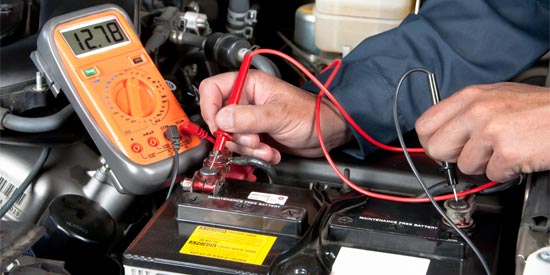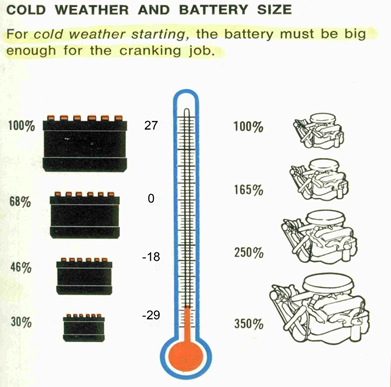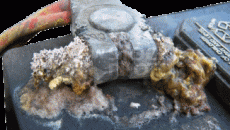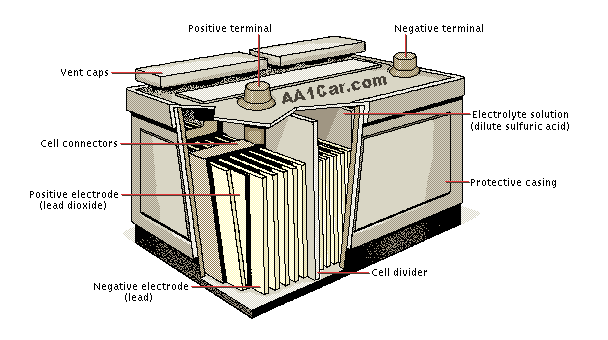Keep An Eye On These Things And Prevent Your Car Battery From Giving Up On You
Some of you must have faced trouble trying to start your car/jeep during the winter season. One of the reasons is that the colder the temperature, the weaker the battery becomes and the more “heavier” the engine. The oil in the engine becomes thicker with lowering of temperature making it more difficult for the starter to turn over the engine. Please see the chart below. Another major reason is that with time the plates of the batteries deteriorate. Pakistani batteries with reasonable care should give you trouble-free service anywhere from 24 months to 30 months. Japanese batteries, those that come fitted in the imported vehicles, can last up to 5 years easily. Anything over this is a bonus but it would be advisable to change the battery once this time is over, if reliability is what you want. Female drivers might want to keep this is mind.
There are certain things you can do to ensure that your vehicle’s battery remains fully charged and able to perform at its optimum. These are:
- All batteries lose water, especially during summers, so it is necessary to top up the battery electrolyte (1 part Sulfuric Acid and 3 parts distilled water). The part that evaporates is the distilled water, so remember to use only distilled water (this is water that is almost 100% pure – no minerals). Do not use anything else; otherwise it will affect the life of your battery. And whatever you do, do not use those bottles that contain liquid red in colour. These will only reduce the life of your battery. You would be better off just using tap water instead.
![corrosion]()
- After some time the battery clamps and terminals get corroded or have a film of rust on them. Due to this the alternator is not fully able to pass the current to the battery nor is the battery able to pass the required current to the starter. All you have to do is to remove the battery clamps with a wrench and poor boiling hot water on to the battery clamps and terminals. Then reinstall the battery clamps and tighten to where the clamps fit snugly on the battery terminals. At this time it is advisable to clean the other end of the earth or negative cable of the battery. If you do this you will notice a marked improvement in the cranking speed of the engine. If you don’t have the tools or knowledge you can go to an electrician and ask him to do it for you.
- All belts, whether for fans, alternators, ACs or steering pumps will either wear out or crack and finally break. In the case where the fan is driven by a belt (many new model cars have electric fans which do not use belts), breakage of the fan belt means the both the fan and water pump will stop working. Immediately you will notice the engine water temperature rising, and if you were not paying attention, a little later you will notice steam coming out of the radiator. To avoid this inspect the belts and make sure that they are not loose or have cracks. But remember not to over tighten the belt either. A word of caution: it is cheaper to replace the fan belts than pay for a new cylinder head or to overhaul the engine.
- When replacing the battery, it would be advisable to fit a battery that is a little bigger in capacity than the one that was factory installed. For example if your Suzuki Alto came with a 30 Amp-Hour battery, you should go for a 34 or 36 Amp-Hour battery. The size of all three batteries is the same (all battery manufacturers follow standard battery sizes ). The difference is in the number of plates in the batteries.
- Another thing you could do is to use a multi-viscosity oil (SAE 15W-40 or 20W-50) in the engine instead of a single viscosity oil (SAE 40 or SAE 50). This will put less load on the battery and the starter. Remember that the life of a starter will be much longer if the engine starts immediately as compared to if it takes 5 seconds or more. The longer the starter remains engaged, the hotter it gets resulting in premature failure. Also the bushes will wear out sooner.
- When starting your vehicle you can follow these steps. In the case of diesel engines use the heaters (installed in the cylinder head ), fully depress the clutch pedal and then turn the ignition key. Older vehicles (with diesel engines) have a manual system where the time you want to keep the heaters on is up to you (the colder it is the longer the heating is required). Newer vehicles have a system by which temperature sensors set the length of time according to how cold it is. For example in Rawalpindi the heaters of the vehicle would be on for 3 seconds, whereas if you took your vehicle to Nathia Gali (altitude 8,500 feet and a lot colder) it would take 8 to 10 seconds.
- For vehicles with petrol engines you should use the choke (it cuts of the flow of air to the carburetor making the fuel mixture richer resulting in easier starting of the engine) as well as fully depressing the clutch pedal. How much you pull out the choke depends on the temperature. The colder it is the more the choke is pulled out. But remember you will have to determine how much to pull out the choke, otherwise if excess fuel goes into the carburetor even then the engine will not start. The reason for fully depressing the clutch pedal is that it helps to reduce the load on the starter.
- Last but not least is the amount of charging the alternator does. All alternators have regulators, which if correctly working, provide the right amount of current to the battery. Once the battery is recharged, the regulator cuts off further supply of current to the battery. This would be analogous to the thermostat of an air conditioner. The compressor runs up to temperature setting of the thermostat and then shuts off. When the temperature rises the compressor comes on again. So if the alternator provides insufficient current the battery will remain weak or if it over charges, the life would be considerably reduced. I will suggest that whenever you want to have your vehicle’s battery or charging system checked, you should go to a battery shop having a meter that checks the battery condition, level of charge and the level of charging being carried out.






and check that voltage of alternator when engine is at fast idle should be no more or less than 14 volts.
making fan direct also puts additional strain on battery during starting.
groundin points should be perfectly clean especially main ground on gearbox and front of chassis in most japanese cars.
never use “direct tezab” in batttery 😛
and in the end save your skin eyes and clothes from electrolyte.
Thank you